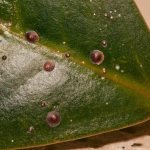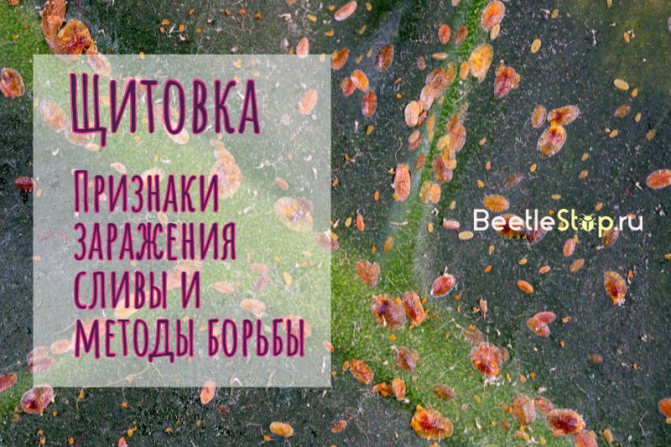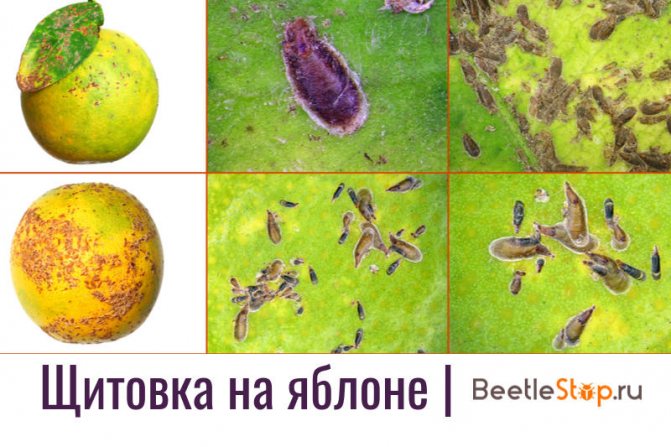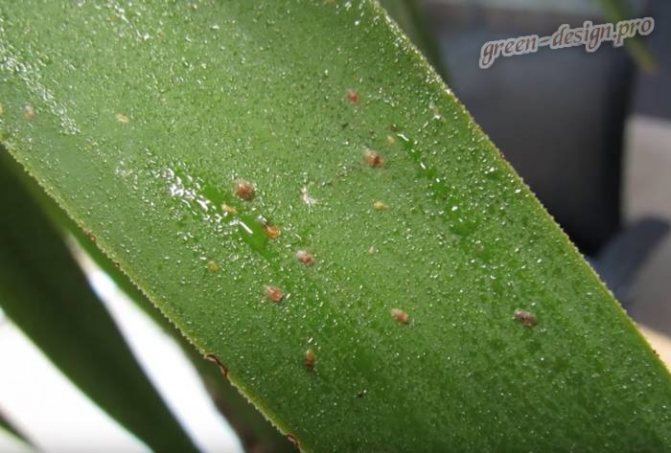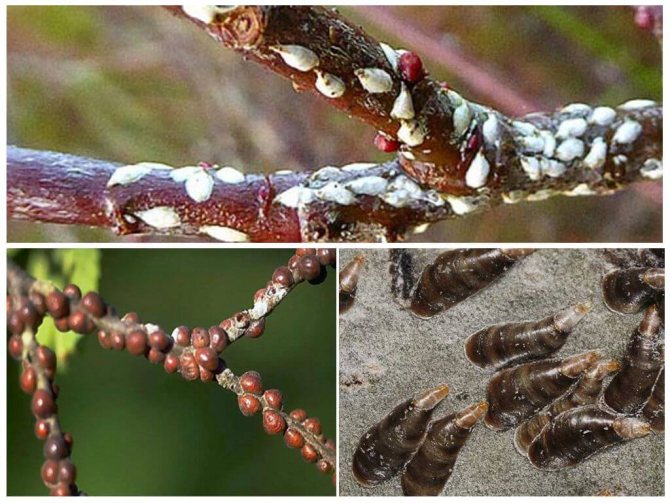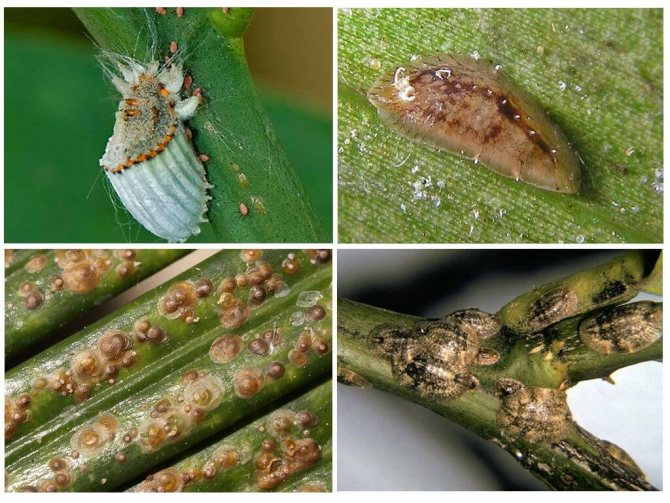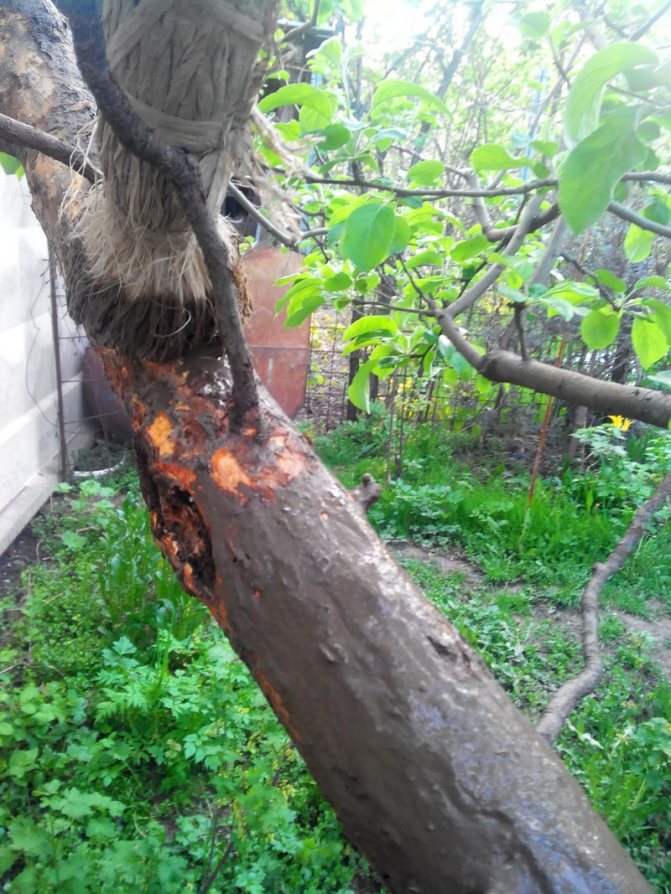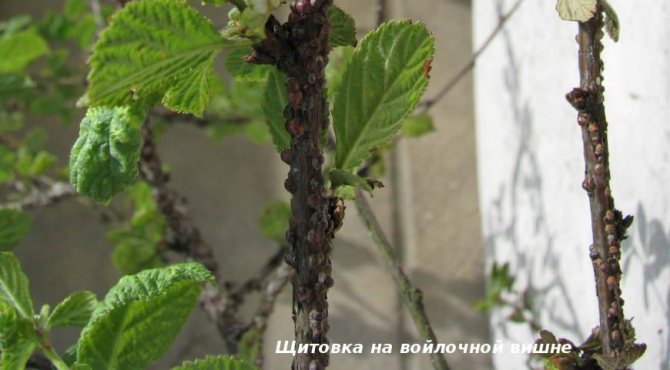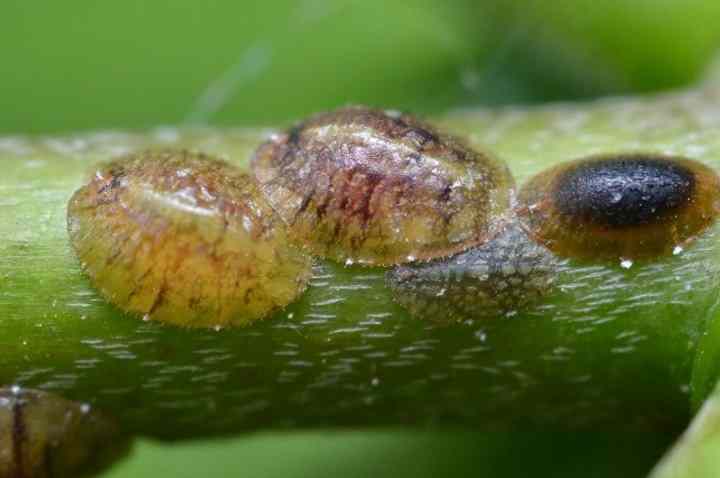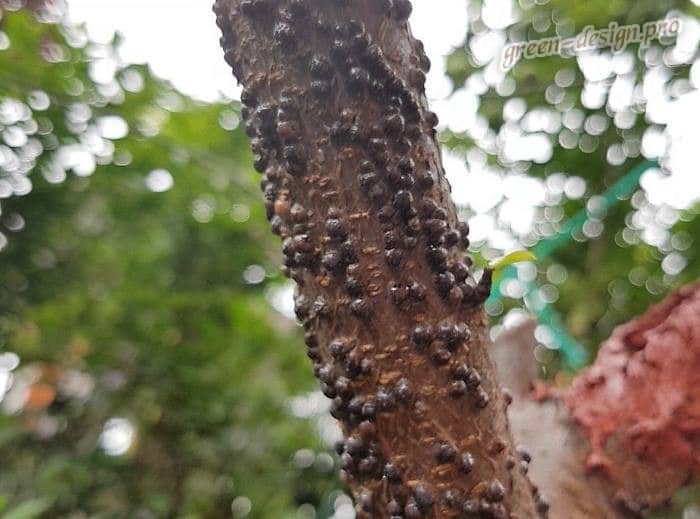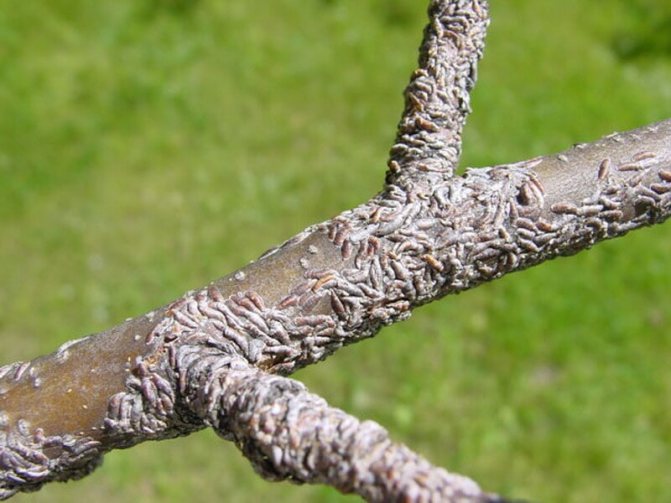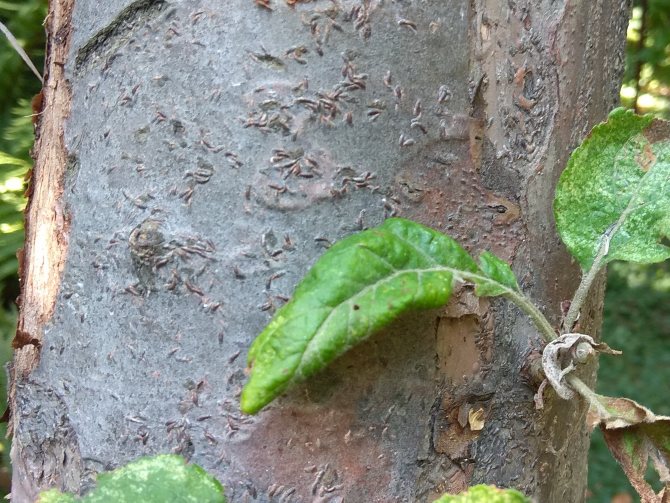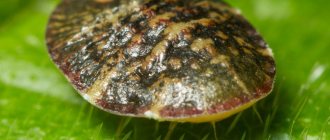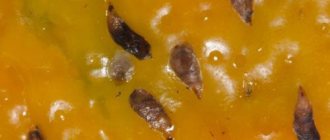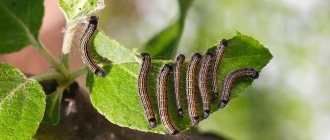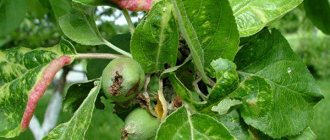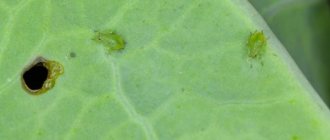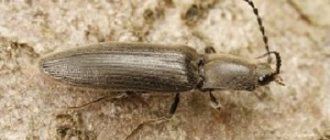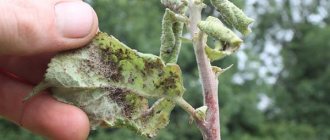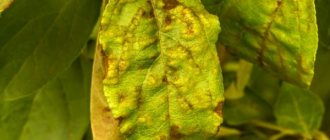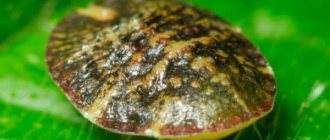Recognizing the enemy
Scabbard or shield aphid (Diaspididae) - sucking pests of the Homoptera family, suborder Coccidae. Depending on the species, an adult insect has a size of 0.5 to 5 mm, its body is covered with a kind of wax carapace-shield (hence the name), which serves as a reliable protection.
Individuals of different sexes are very different from each other (sexual dimorphism). Females have neither legs nor wings, sometimes they even lack eyes. Their carapace is more convex and rounded. Males are slightly smaller in size, have a pair of wings, normal limbs, a flat slightly elongated shell and reduced (simplified, underdeveloped) mouth organs. After mating, the males die. Females are less common than males and are completely motionless.
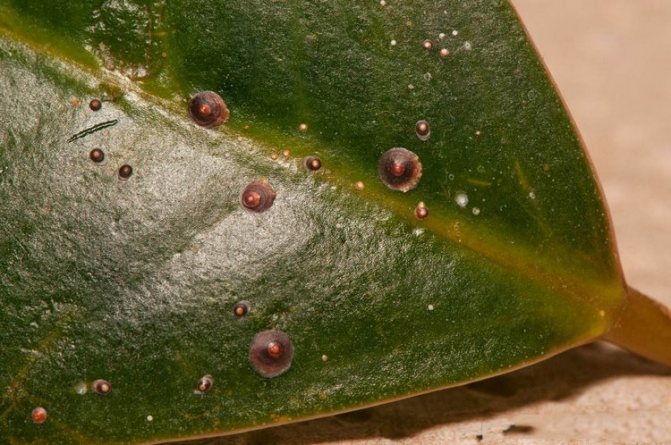
Shield or shield aphid
In most species of scale insects, females lay eggs, but viviparous specimens are also found (for example, Californian scale insects). Larvae appear from the eggs, which at first move very actively.
Having chosen a suitable place and sticking to the plant, the larvae become immobile. Gradually molting, they are covered with a shield of discarded skins and wax secretion. The scutes are rounded or more oblong, brown, brown or white.
Shields are very similar to false shields. The difference is that false shields do not have a wax shell, and the female's skin, dying during molting, plays the role of a shield. Drying, it rises above the body, creating protection for the insect and the eggs being laid.
Getting rid of the mole with folk remedies A funny mole from a cartoon or a businesslike mole from a fairy tale about Thumbelina actually turns out to be not so much ...
There are several types of scale insects. They are called so because of a kind of wax shell. It reliably protects them from enemies and various drugs.
The scabbard on the apple tree is a fairly common pest, with which, if possible, it is necessary to start the fight as early as possible.
Both sexes are significantly different. Females have no wings, no legs, and some species have no eyes. The scutellum of females is more convex and has a rounded shape. Due to the lack of legs, the females do not move.
The size of the males is slightly smaller, they have wings, eyes, limbs. The shell of males is elongated. The males also have oral organs. When the breeding process is completed, the death of the males occurs.
Prevention measures
To prevent infection, certain preventive measures must be taken.
Quarantine
Only a healthy seedling is used, infected specimens must be removed.
Mechanical cleaning
At the first symptoms of infection, the affected shoot is pruned. Mechanical cleaning with sharp objects can also be used. The bark with the pest is removed. This procedure is troublesome, but does not require the use of chemicals.
See also
How to dry plums at home, preparation and best ways
To read
Important. It is not recommended to use mechanical cleaning on young seedlings.
Natural enemies
In case of small accumulations of the pest, natural enemies can be used. These are ladybugs that feed on harmful insects.


Removing unnecessary trees
Very often, the pest appears on old trees that practically do not produce a crop. Such crops must be removed, replacing them with healthy young seedlings.
Causes of infection of garden trees
Usually, the scabbard gets to the site with newly acquired seedlings or grafting material. Sometimes their larvae are carried by birds or the wind (if the affected trees are not very far away).
To avoid this, you need to carefully examine the purchased cuttings or young seedlings. Even if nothing was noticeable on them, after planting the trees, it was imperative to frequently inspect and systematically examine the entire garden. Gardeners recommend paying the most attention to the appearance of plants.
Most often, the scale insect enters the garden with contaminated planting or grafting material. The larvae can be carried by birds, and the mulberry scale can even be carried by the wind.
Therefore, when buying young seedlings or cuttings for grafting, carefully examine them. And in the future, conduct a systematic survey of the garden, pay attention to the change in the appearance of plants.
The main preventive measures are:
- crown thinning:
- timely removal of dried and damaged branches, dead trees, root growth;
- cleansing of damaged and lagging bark on boles and skeletal branches;
- correct watering and application of the necessary fertilizers, since a strong plant is more resistant to pest attacks.
Rating of affected crops
Scabbards can inhabit absolutely any tree or shrub, they can be found in greenhouses, in a greenhouse, in a winter garden, and even on indoor plants in an apartment. The comma-shaped scabbard can settle on:
- apple tree;
- pear;
- plum;
- cherry;
- cherry;
- quince;
- peach;
- apricot;
- hawthorn;
- mulberry;
- turn;
- cotoneaster;
- mountain ash;
- currants;
- birch;
- linden;
- ash tree;
- lilac, etc.
This list can include at least 150 more plant species belonging to thirteen families. In the willow scale insect, tastes spread to trees, shrubs and herbs from 17 families. For some species of scale insects, even poisonous compounds that protect certain plants, for example, white turf and laurel, are not scary.
Larvae
There are several forms of Californian scale insect larvae:
- The Vagabond is a newly hatched individual. It has an oblong-oval body, the length of which ranges from 0.2 to 0.3 mm. It has legs, eyes, a well-developed oral apparatus, the dimensions of which may exceed the length of the body.
- Nymph is the transitional stage of the larva, at which the formation of the chitinous shield takes place. The body takes on an oval shape. During this period of development, the Californian scale insect changes color from gray to dark black.
Imago
Let's take a comma-shaped shield as an example. Damage to the plum is caused by the female, piercing the bark of the tree and leaf tissue with her proboscis, and her larva. Insect saliva contains substances that have a destructive effect on the cells of the plum tree. The female scale insect is capable of laying up to 100 eggs during its life cycle. In places of large accumulation of female larvae, internodes dry up, and young shoots die altogether, and very quickly. The yield is falling. For the winter, adults climb into the folds of the bark. If you look closely in early spring, you can see the larvae on thin twigs, which they begin to devour.
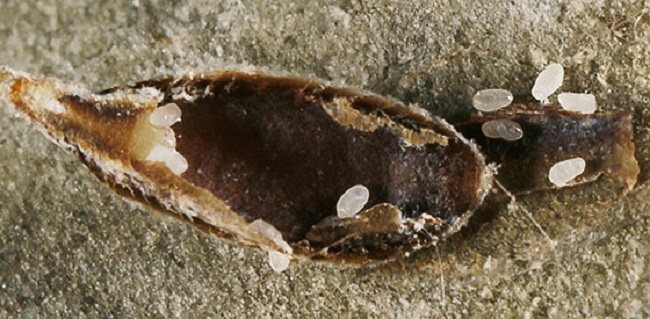

The shield where the eggs were kept
External signs of plant damage by scale insects
First of all, you can find out about the defeat by the appearance of a plaque. It is sticky and very similar to syrup. Gardeners call this plaque honeydew, honeydew. This secretion is left by sucking insects - one of the types of scale insects.
This photo shows a close-up false shield, this pest can appear not only on an apple tree, but also on other fruit plants.
If plaque has appeared, it is necessary to carefully examine the plants, especially the trunks and branches. Dirty white or greyish brown plaques can be seen on them. These are adult larvae and females sucking juices from the plant.
It is not for nothing that scale insects are considered intractable pests - thanks to their excellent protection, they even withstand chemical treatment. Sometimes a scraper or wire brush may be more effective.
It is easier to remove the scabbard on infected seedlings: it is necessary to treat them with a brush, and then rinse with a solution of laundry soap. So that the whole procedure does not turn out to be useless, experienced gardeners recommend treating the soil around the plants with chemicals or replacing it, which is much more effective.
The photo shows a close-up of a comma-shaped scale insect that has settled on a branch of a fruit tree.
Large trees are more difficult to wash, therefore, having processed them with a brush or scraper, they are treated with one of the preparations given in the table below.
We suggest that you familiarize yourself with the best remedy for bedbugs
| Name | Benefits | disadvantages |
| Fosbecid (Aktelik) | The product can be used to treat seeds. Pests don't get used to it. The drug completely eliminates insects, and they do not reappear. | The presence of an unpleasant odor. High toxicity. |
| Aktara | Recognized as an effective drug. Do not allow re-infection. | Bad smell. The drug is dangerous for bees. |
| Bitoxibacillin | Has no smell. The drug is safe, completely harmless to animals and people. This drug consists of living bacteria, which destroy the scale insects at all stages of their development. | Reprocessing required. It can only be processed when the temperature outside is above 18 degrees. During processing, be sure to use a respirator and wear gloves. |
| 30 Plus | Environmentally friendly product. It is a mineral oil emulsion based on vaseline oil. Removes many types of pathogenic flora and spores of parasitic fungi. | Dangerous for bees. It is allowed to use only in spring, while the flowers have not yet bloomed. |
If the infection is strong, after the end of flowering, you can carry out the treatment using one of the following means:
- Karbofos.
- Rovikurt.
- Rogor.
Sometimes brown or light rounded scales appear on the leaves of plants, which are difficult to separate from the leaf. This is the adult stage of the scale insect.
Pseudoscale lesion: leaves that have lost their luster, turned brown and are covered with sticky secretions. The pest sucks out cell sap from leaves, stems and fruits. As a result, yellowish or reddish-brown spots are formed on the damaged areas, which can lead to the death of plant parts.
The main sign of the appearance of a pest is the formation of light and brownish rounded scales on the leaves of trees. The latter are rather difficult to separate from the surface. Such manifestations indicate the presence of adults of the Californian scale insect.
A sign of the spread of pest larvae is the loss of natural shine by the bark of trees. Damage to plants by developing insects also leads to sap drips on branches and trunks, and leaves sticking together.
Brown and red spots form on damaged areas of wood. In the absence of actions aimed at destroying the insect larvae, these areas subsequently die off, which leads to the gradual drying of the plant.
The first sign that your plant is infected with a scabbard will be a sticky, syrup-like plaque on the leaves. This discharge is called honeydew or honeydew. They are formed as a result of the vital activity of sucking pests.In these secretions, a sooty fungus is actively developing, which causes serious damage to plants.
Having examined your "green friend", you will also notice gray-brown or off-white plaques on the trunk, branches, and the lower part of the leaf. These are females and adult larvae that suck the sap from the plant.
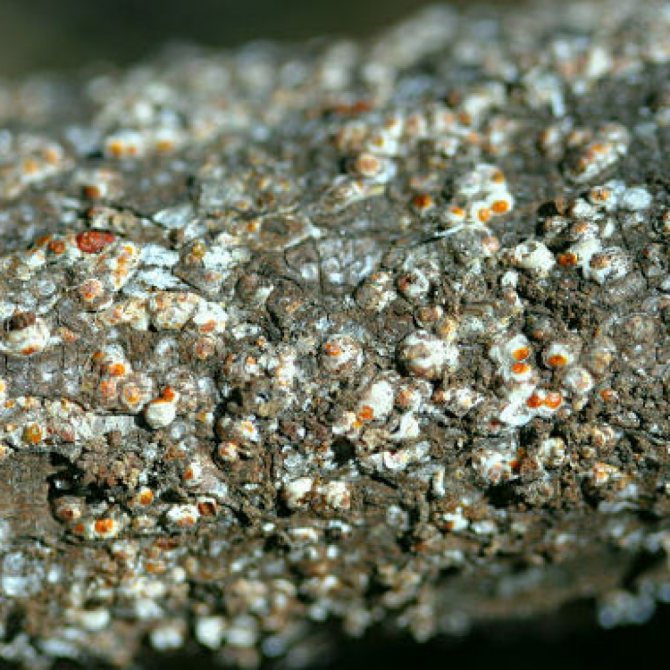

Fall or honeydew


For example, the Californian scale insect (like many other types of scale insects) in the first year after infection leads to the growth of new tissue in the damaged areas. Therefore, tuberosity and unevenness of the bark are formed.
Affected leaves first turn red, then deform and fall off. In the second year of infection, large colonies of scale insects are already formed, the growth and development of the plant slows down, some branches die. In the third year, the branches and leaves begin to dry out, the bark cracks.
And the mulberry shield, sucking out the juice, weakens the plant, the fruits become smaller, the yield decreases, they lose their presentation, spots appear.
Sometimes the accumulation of scale insects is so large that they can be mistaken for growths on the bark. Young plants suffer most of all, since they have little strength to fight the pest, they often die.
Unfortunately, it is not always possible to immediately notice the scabbard plaques, and when the infection becomes noticeable, it is already quite difficult to fight.
Methods of dealing with the larvae of the May beetle The main description of the pest May beetles, they are also May beetles - insects of the order of coleoptera, family ...
PROCESSING FROM THE APPLE PALACEOUS SHIELD: VIDEO
Alexander Petrov. Treatment for apple comma and acacia scabbard
ORDER QUALITY AND CHEAP SEEDS AND OTHER PRODUCTS FOR HOME AND COTTAGE. PRICES ARE BOTTLE. CHECKED! JUST SEE YOURSELF AND BE AMAZED. THERE ARE REVIEWS. GO >>>
Below are other entries on the topic "Cottage and garden - do it yourself"
- Fight against pests overwintering in the bark of trees: Overwintering in fruit trees - ...
- What to plant instead of a dead tree or garden rotation: What tree can be planted after ...
- Top 5 useful weeds for the garden: WEEDS - USE WITH USE ...
- If the plums are all wormy ...: Wormy plums - what to do? IN…
- Birds in the garden - we are not fighting, but friends: Birds are good, not ...
- We get rid of pests without chemicals - folk remedies: Folk remedies for pests in ...
- Whitewashing fruit trees in February-March: how, when and with what - questions and answers: Should you whitewash trees in February? What for…
Subscribe to updates in our groups and share.
Pest control measures
Due to the rapid reproduction of this insect species, it is very difficult to defeat the pest. In addition, it has an excellent protection against pesticides - a shield. But, the complexity of the struggle does not mean its ineffectiveness.
- Mechanical. Effective at the initial stage of infection. This option foresees that the insect is simply eliminated with tampons or sponges dipped in alcohol. In addition, the affected branches are removed. But they are not left behind, but must be burned.
- Folk. This option is acceptable when there are still few scale insects on the plant. Trees are sprayed with a solution of pepper, garlic, celandine. Alternatively, make an infusion of tobacco, dilute engine oil with a soapy solution. Such funds will help in the fight against young larvae, but it is unlikely that it will be possible to get rid of adult insects in this way.
- Biological. We are talking about entomophages. They will help get rid of the mulberry scabbard. The biological method is also the use of fungicides, which are created on the basis of pathogenic nematodes or fungi. Such drugs are Nemabact, Aversectin. These remedies can be effectively fought against the Californian scale insect.
- Chemical. Pesticides are indispensable in the fight against such a serious enemy of gardens. But even potent insecticides may not give the expected result, if you do not take into account the development cycle of the scale insect.It is best to use chemicals at a time when the larvae appear - during this period they are vulnerable and can be eliminated.
In this photo, you can see what a tree post looks like, which has been hit by a pest called a comma-shaped scabbard.
The California scale insect is absolutely unpretentious in nutrition. The rapid growth of the population and active reproduction is also facilitated by the absence of natural enemies. That is why the insect has taken root well in American and European gardens.
We offer you to familiarize yourself with Effective poison for mice - the best way to get rid of the pest
Scabbards are located in numerous colonies on the branches, fruits and leaves of cultivated plants. In the process of development, the larvae suck the sap from the trees, which leads to cracking and death of the bark. Depletion of plants impedes their growth, causes deformation and a decrease in fruit.
Trees affected by large colonies of scale insects often lose their ability to produce crops, since the main reserves of nutrients are used to restore the structure of leaves and bark.


The fight against the Californian scale insect is extremely important, since plants affected by the pest die even in mild frosts. Actions aimed at protecting fruit trees are taken at the beginning of March, when the plants have not yet formed buds.
The larvae of the Californian scale insect hibernate on the bark of branches and trunks, hiding from external influences under strong, well-insulated chitinous shells. With the arrival of heat during the turning of the juice, the insects wake up and begin to feed.
Males are active in breeding by mid-May. Their number is about 10% of the total population. Each female gives birth to up to 100 larvae over a period of several months. The latter creep in huge quantities along the branches of trees, stick to the bark and are covered with shields, which act as a natural defense for them.
Having dropped the shield, the males mate, after which they die. In early August, females stick to plants, continuing to consume nutrients, and with the onset of cold weather they go into hibernation, covered with a more durable shield.
The Californian scale insect sucks sap from the trunks, branches, leaves and fruits of trees of various species. Typical polyphage. More than 150 species of woody plants can act as forage trees.
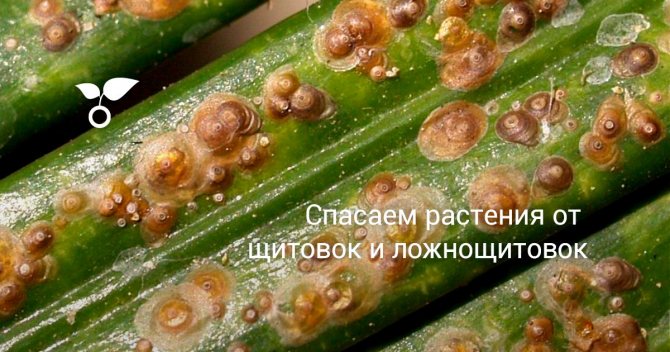

Due to the vital activity of the insect, cracking and dying off of the bark, summer leaf fall, curvature of shoots, a decrease in growth, drying out of some branches and even complete death of the plant can occur.
It is difficult to fight the scabbard, since it multiplies quite quickly, and the scutellum protects it from the effects of pesticides. All used methods of struggle can be divided into groups.
- Mechanical. At an early stage of infection or if the plant is small, the affected sheds or branches should be removed (and then burned). You can try wiping insects off the leaves with a soapy sponge or a swab dipped in alcohol.
- Folk. In the fight against the scabbard, folk remedies do not give good results. You can try spraying with a mixture of engine oil and soapy water (1:10), the procedure should be carried out at least three times every 10 days. Various herbal infusions are also used: onion, garlic, pepper, fern, tobacco, celandine, walnut. A mixture of 1% coniferous concentrate with 0.5% laundry soap solution and 0.2% salt solution is effective against young larvae (vagrants).
- Biological. Entomophages (for example, blastotrix and others) can be used against scabies. The mulberry and false shield are especially sensitive to biological agents. Also, biological methods include fungicides based on fungi (avertin, aversectin) and pathogenic nematodes (nemabakt). These drugs can be successfully used in the fight against the Californian scale insect.
- Chemical.Unfortunately, it is impossible to cope with such an insidious pest as the scale insect without pesticides. But even when using potent insecticides, it is imperative to take into account the development cycle of these insects. Since the shell is a fairly good defense, the most vulnerable are young vagrant larvae.
The first stage of the fight should be carried out in early spring (before bud break). This will help get rid of the hibernating larvae. During this period, plants are sprayed with nitrofen, karbofos, drug No. 30, oleocobrite, bottom.
When spraying with oily emulsions, a film forms, which deprives the shield of air access, and also, flowing under the shield, poisons the insect.
In case of severe infection, the plant should be sprayed with karbofos, actellik, rovikurt or rogor immediately after flowering. Good results are obtained by the drug Aktara, they can be sprayed on the plant itself and the soil under it.
The dosage of pesticides is always indicated on the package and must be observed. And since they are all quite toxic, do not forget about caution and personal protective equipment.
The scabbard is a very insidious enemy, the fight against it is always long and difficult. But now you know how to get rid of the scale insect in the garden. Having processed the plants correctly and in a timely manner, you will cope with 90% of these pests.
Popular insecticides
- before processing, it is better to take the flower pot to the balcony or loggia;
- processing is done with gloves and glasses. A respirator is required!
"Actellik"
This is a fairly effective remedy. They are sprayed with indoor plants and water the soil in pots. Can be used for the treatment of horticultural crops and storage facilities (including barns).


1.5-2 ml of the product is dissolved in one liter of water. The whole plant is sprayed with the resulting solution. The remains can be poured into the soil under the roots.
Effects on insects over a period of several minutes to several hours. The performance is determined by the state of the insect and the air temperature.
Protection lasts up to three weeks. Warehouses can be processed every eight months.
- prevents the reappearance of pests;
- there is no addiction in insects;
- can be mixed with other insecticides for maximum effect;
- seed treatment is permissible (for prophylaxis).
- unpleasant odor;
- dangerous for pets and children;
- not recommended for residential use.
"Aktara"
It is used to combat all sorts of pests. The agent can be sprayed on plants or injected directly into the soil.


For indoor plants, 0.5-1 ml of the product from a bottle (9 ml) is dissolved in one liter of water. It is best to pour the solution into the soil. Then the poison will saturate all the leaves and destroy the scale insect.
Trees and plants in the open field are treated with a sprayer.
First, one packet of dry insecticide (4 g) is diluted in 1 liter of water. The resulting milk is diluted with water in the spray tank. For a quarter of a tank of water, you will need 600 ml of flower treatment, 250 ml for currants and trees.
Pests die in a day.
- efficiency;
- can be used with growth stimulants;
- not addictive.
- unpleasant odor;
- the product is toxic to bees;
- it is impossible to carry out processing in a residential area.
"Bankol"
It is used for spraying both indoor plants and garden.
Has a contact effect. Damage to the nervous system and paralysis in pests occurs within one to two days.
In floriculture, a solution of 0.5-0.7 g is used per liter of water.
Advantages:
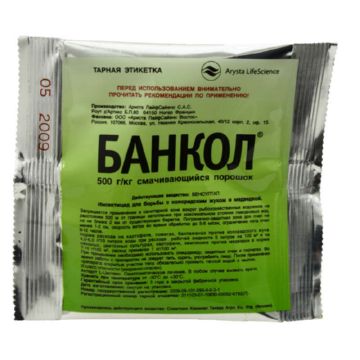

- low toxicity to humans, animals;
- poorly washed off from plants by rain;
- it is permissible to combine with growth stimulants;
- has no smell.
- most effective at high air temperatures;
- does not apply to garden treatment.
"Bitoxibacillin"
In addition to insecticide, contains bacterial
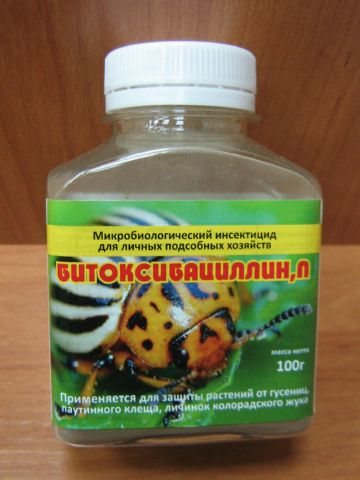

complex. Acts on pests through intestinal damage.Within a day, insects cannot feed. Three days later, their mass death begins.
35 ml of the product is dissolved in 5 liters of water. Houseplants and trees can be processed.
- repeated processing is required;
- outdoor efficiency depends on the ambient temperature (permissible minimum +18 degrees);
- cannot be used without personal protective equipment.
The nodule weevil can eat up to two square meters in one day. see greenery. How to deal with this pest, read here.
Development
... Development


, having successfully survived the winter period, begins simultaneously with the sap flow of forage plants. At this stage, the development of females and males is the same.
... In the central part of the rounded
appears
the skin is yellowish.
We suggest that you familiarize yourself with Aphids on roses: how to treat and how to get rid of aphids
and the eyes are reduced. After 10-15 days, secondary
and becoming an adult female.
develops within 30–33 days. The end of development coincides with the appearance of adult males.
going through two more
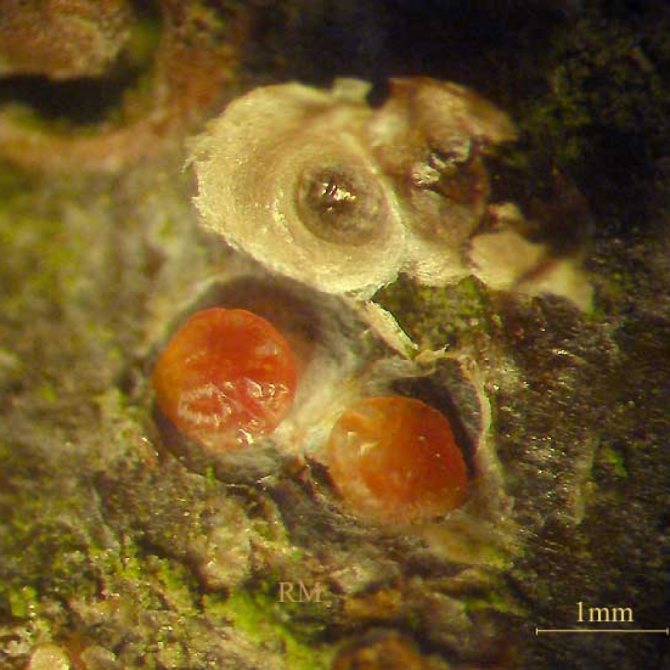

, successively going through the stages of pronymph and
, and turns into an adult insect.
... The flight of males and the appearance of females coincide. In the Sochi area, the number of males exceeds the number of females by two to three times. In Georgia, this ratio is approximately equal. In Transcarpathia, males make up about 7-9% of the total number of insects.
The life of males is short - from several hours to several days.
... When
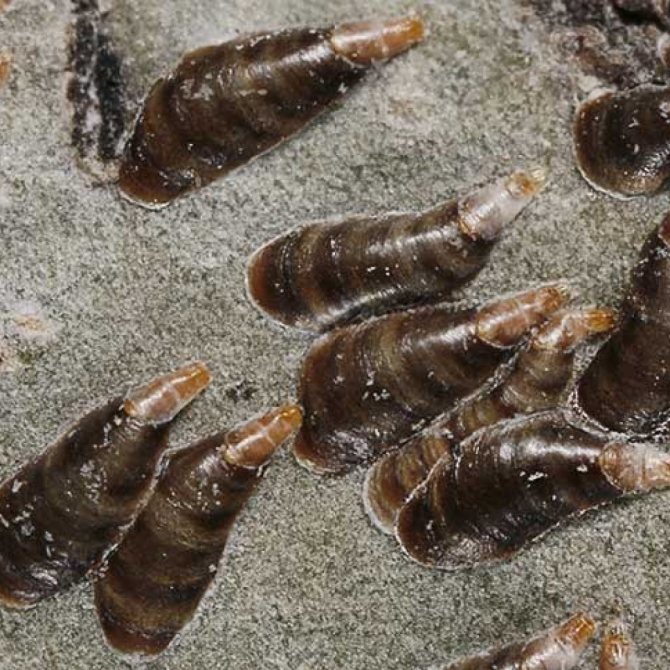

Californian scale insects have been reported
but this way
is not predominant.
takes place at the end of the first decade of May (Transcarpathia).
After this, the maturation of females lasts about a month. Hatching
stretches for another two months. The fecundity of females of the Californian scale insect ranges from 87 in the Primorsky Territory to 138 in the Maykop area and 587
in some areas of the United States.
Preventive control measures
There are several important rules, the observance of which will help preserve the garden and prevent infection:
- Timely thin out the crowns.
- Permanently remove branches that are withered or damaged. At the same time, you need to remove the root growth, dried trees.
- To clean the bark that has lagged behind the trunk or is damaged on skeletal branches and boles.
- Fertilize and water the trees correctly. If the plants are strong, they are rarely affected by pests.
The scabbard usually appears on trees, or rather on poles or on branches, sometimes you can see a scabbard on green branches.
Especially in late winter and early spring, you need to take care of a well-ventilated place, you also need to frequently spray the plants with water, and regularly inspect them, especially from below.
Shields are protected from external influences by a shield, so the fight against them is not easy. The scabbards are cleaned with a toothbrush or a cloth soaked in alcohol or soap solution, you can also use a soap-kerosene emulsion.
Alcohol solution with soap. The mixture consists of 15 grams of liquid soap, 10 ml of denatured alcohol and 1 liter of warm water. However, one must be very careful here, especially for soft-leaved and thin-leaved plants.
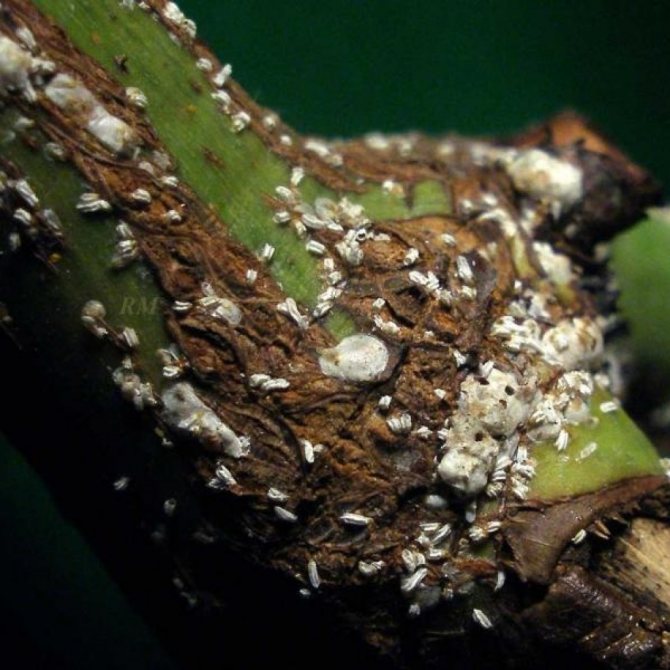

These species are very sensitive to alcohol, therefore they are not sprayed with liquid, but applied to the insects themselves with a brush. If you really want to use this method, it is best to do a small sensitivity test on one sheet first.
Actellik. Dissolve the ampoule in 1 liter of water and treat it during the appearance of the pest. Solution consumption up to 2 liters per 10 sq.m. No more than 4 treatments. The waiting period is 3 days.
"Fosbecid". Treatment with these drugs (they are toxic) is best done outdoors (20 ml per 10 liters of water).
They destroy the pest by spraying trees. They resort to the procedure when the air temperature at night is not lower than 4
C. Otherwise, the liquid in the working composition may freeze.
What chemical kills the California scale insect? The trunks and crowns of trees are sprayed with neonictionides, pyrethroids, agents that contain organophosphorus compounds. The treatment is carried out by washing the plants.
In other words, the trees are completely covered with the liquid chemistry. Only this approach can count on the complete destruction of the larvae and the creation of conditions that prevent the reproduction of adults.
Considering how to deal with the Californian scale insect, it is worth noting such an effective remedy as mineral oil. The result of the treatment of cultivated plants with the specified solution is the formation of the thinnest airtight film on the surface of the latter.
Enveloping trees with such a means causes the rapid death of scale insect larvae due to a lack of oxygen. Mineral oils for treating trees are safe for humans. They can be used even if there are ripe fruits on the branches.
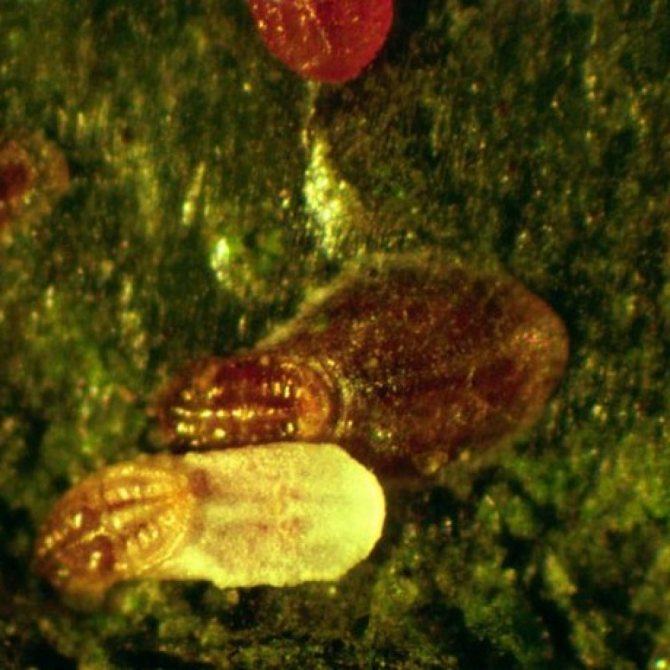

A prerequisite for preparing trees for chemical treatment is the preliminary removal of dead bark and dry branches, leaves, root growth, and thinning of crowns. Formed cleaning is collected in one place, and then incinerated.
Traditional methods


Folk recipes for the pest There are many folk methods that have been tested by gardeners for more than one decade to combat the scabbard on a pear, apple, peach, etc .:
- Applying a solution of grated laundry soap and chopped garlic in a 1: 1: 3 ratio with water. Sick plants need to be sprayed, and after a day they should be washed with clean water from a hose. The procedure must be repeated every 3 days until the parasites disappear.
- Onion infusion is made from 4 onions, filled with 1 liter of water, leave for 3-4 hours, then strain and apply for spraying.
- Pour fresh chopped hot pepper 100 g with a liter of water and cook for 10-15 minutes, then insist for a day and filter. When processing, green soap is added at the rate of: for 1 liter of water 10 g of pepper tincture and 5 g of soap;
- Pour 300 g of wood ash with 1 liter of boiling water, cook for 30 minutes, cool and strain, dilute with water to 10 liters and spray the planting.
- Insist 3-4 kg of fresh celandine in 10 liters of water a day, can be used for watering and processing trees.

